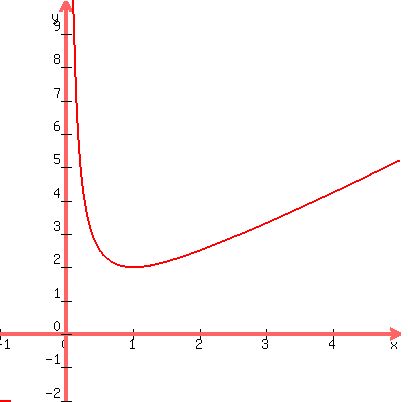.
In calculus, the Extreme Value Theorem states that if a real-valued function f is continuous on
the closed interval [a,b], then f must attain a maximum and a minimum, each at least once.
See this Wikipedia article
https://en.wikipedia.org/wiki/Extreme_value_theorem
So, the function is assumed to be CONTINUOUS.
The given function is the sum of two elementary functions, x and  .
Each of the two functions is continues on the given interval, as it is known from Calculus.
Therefore, the sum of these functions is continue on the given interval.
It proves the statement.
To answer the last question, you need to solve this quadratic equation
x + 1/x = c.
Reduce it to the standard form
x^2 + 1 = cx
c^2 - cx + 1 = 0
Calculate the discriminant
d =
.
Each of the two functions is continues on the given interval, as it is known from Calculus.
Therefore, the sum of these functions is continue on the given interval.
It proves the statement.
To answer the last question, you need to solve this quadratic equation
x + 1/x = c.
Reduce it to the standard form
x^2 + 1 = cx
c^2 - cx + 1 = 0
Calculate the discriminant
d =  .
The equation is solvable in real numbers if and only if d >= 0, which is
c^2 >= 4,
giving
c <= -2 OR c >= 2. (1)
Since our function g(x) = x +
.
The equation is solvable in real numbers if and only if d >= 0, which is
c^2 >= 4,
giving
c <= -2 OR c >= 2. (1)
Since our function g(x) = x +  is always positive on the given interval,
the inequality (1) for "c" is reduced to
c >= 2.
The plot below illustrate the function
is always positive on the given interval,
the inequality (1) for "c" is reduced to
c >= 2.
The plot below illustrate the function
 Plot y = x + 1/x
Next, to get the final description for the range of "c"-values, we should evaluate the function at the ends of the interval
g(3) =
Plot y = x + 1/x
Next, to get the final description for the range of "c"-values, we should evaluate the function at the ends of the interval
g(3) =  = 1
= 1  ; g(4) =
; g(4) =  = 4
= 4  .
Now we select the smallest and the greatest values of these two end-points, which are 3
.
Now we select the smallest and the greatest values of these two end-points, which are 3  and 4
and 4  .
In this way, we obtain inequalities for "c" in the FINAL form
3
.
In this way, we obtain inequalities for "c" in the FINAL form
3  <= c <= 4
<= c <= 4  .
.
The problem is just solved - all the questions are answered.